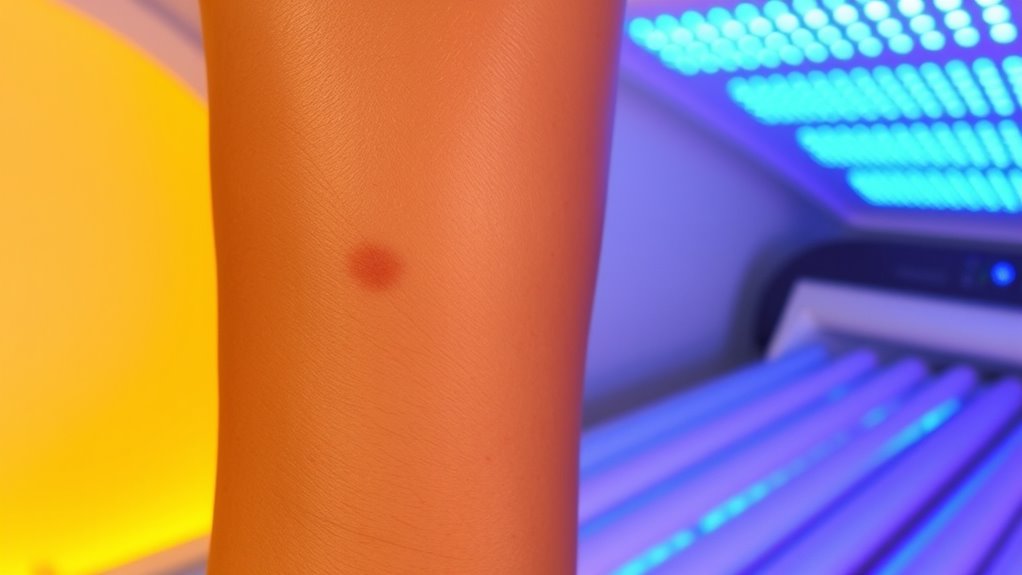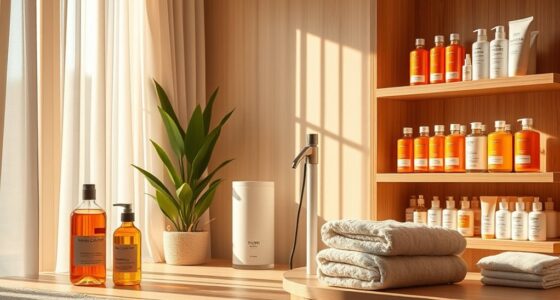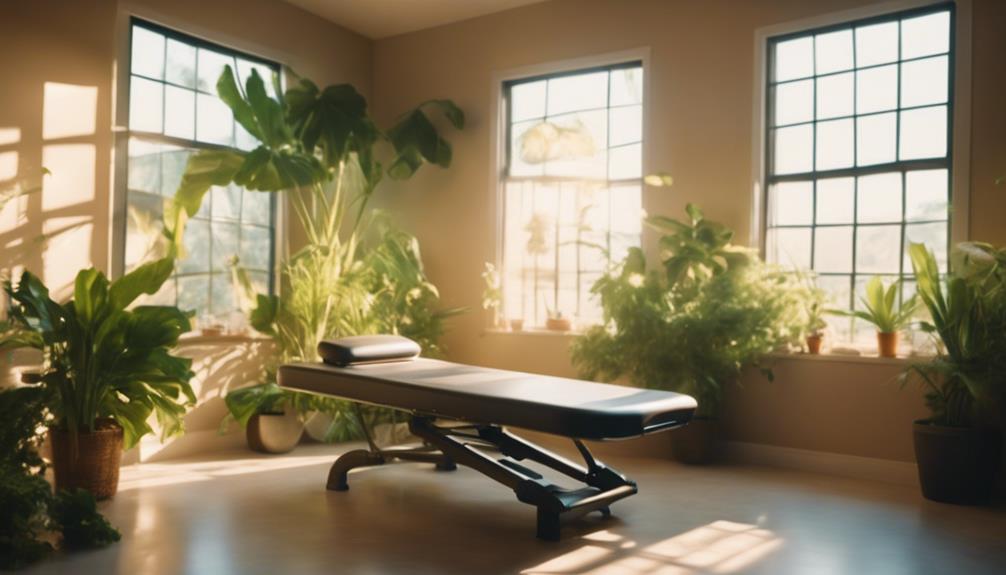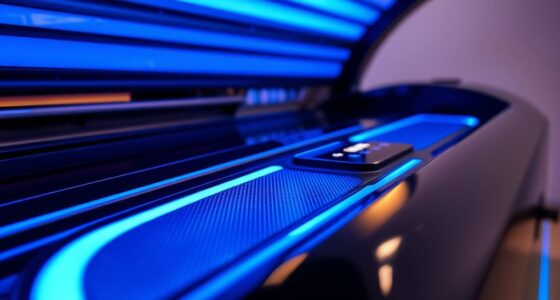Your tanning bed tan fades faster if your skin renews quickly or if you skip proper skincare. Hot showers, harsh soaps, and neglecting moisturizer can dry out your skin and speed up fading. Regularly exfoliating or using harsh products also strips away pigmented cells. To make your tan last longer, keep your skin hydrated, moisturize daily, and protect it from environmental factors. Keep going, and you’ll discover simple tricks to extend your glow even further.
Key Takeaways
- Rapid skin cell turnover naturally causes your tan to fade faster; exfoliating accelerates this process.
- Dry or dehydrated skin sheds pigmented cells sooner, shortening the lifespan of your tan.
- Hot showers and harsh skincare products strip oils, dry out skin, and accelerate fading.
- Lack of regular moisturizing reduces skin elasticity, leading to quicker tan loss and uneven fading.
- Environmental factors like sun exposure, wind, and pollution can speed up the fading process.
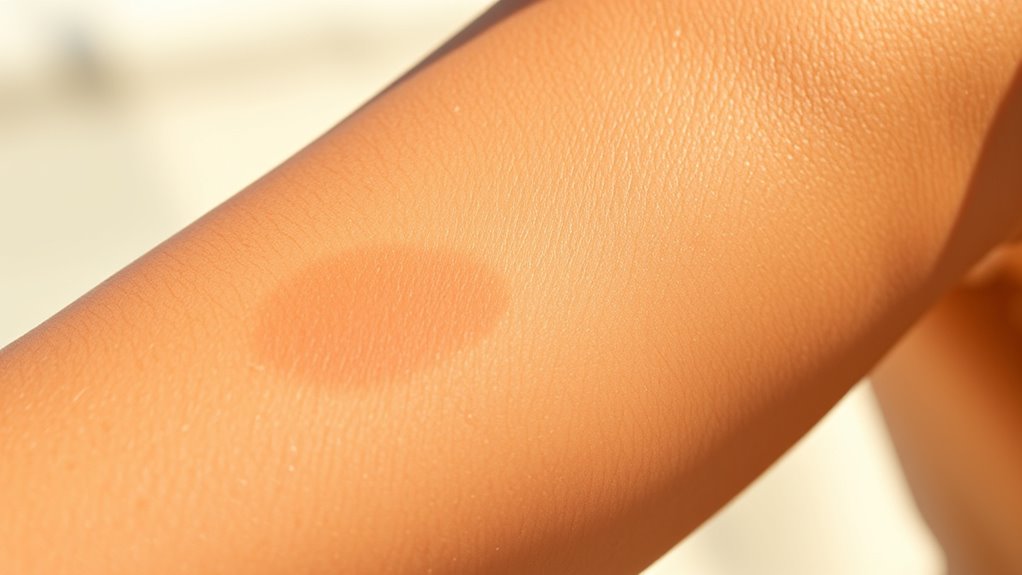
If you notice your tanning bed tan fading faster than you’d like, several factors could be to blame. One common reason is the natural process of skin cell turnover. Your skin constantly sheds old cells and replaces them with new ones, which can cause the tan to fade as the pigmented cells are replaced. This process varies from person to person but generally accelerates with certain habits, such as exfoliating too often or using harsh skincare products. When your skin renews itself rapidly, the tanned cells are replaced more quickly, leading to a shorter-lasting tan. To help prolong your tan, it’s essential to understand and work with your skin’s natural cycle. Avoid excessive exfoliation immediately after tanning, as it speeds up cell shedding. Instead, gently care for your skin, allowing the pigment to stay longer.
Another key factor is moisturizer application. Keeping your skin well-hydrated is indispensable because dry skin tends to peel and shed more rapidly, which can cause your tan to fade prematurely. Applying moisturizer regularly helps lock in the pigment and maintains the skin’s elasticity, giving your tan a more even and longer-lasting appearance. Look for moisturizers that contain ingredients like aloe vera or hyaluronic acid, which hydrate deeply without clogging pores. Don’t neglect areas prone to dryness, such as elbows, knees, and hands, as they tend to lose moisture faster. Consistent hydration creates a barrier that preserves the tan, giving it a richer, more vibrant look for a longer period.
In addition to skin cell turnover and moisturizer application, other habits can influence how long your tan lasts. For example, taking hot showers or baths can strip away natural oils and dry out your skin, speeding up fading. Use lukewarm water and keep showers brief. Wearing protective clothing or applying a tan extender can also help shield your skin from environmental factors that accelerate fading, like sun exposure or wind. Remember, your skin’s health plays a crucial role in maintaining a tan, so avoid harsh soaps or abrasive scrubs that can damage the skin’s surface and make the tan fade faster. Additionally, utilizing a high-quality home theatre projector with good color retention can enhance your overall visual experience even as your natural tan fades.
Ultimately, understanding your skin’s renewal process and keeping it moisturized are the best ways to make your tanning bed tan last longer. By adjusting your skincare routine and being mindful of habits that influence skin cell turnover, you’ll enjoy a more vibrant and enduring glow.
Frequently Asked Questions
Can Skin Type Influence How Quickly a Tan Fades?
Your skin type definitely influences how quickly your tan fades. If you have sensitive skin, it may fade faster because your skin reacts more to UV exposure, leading to quicker peeling or shedding. Additionally, your tanning preferences, like how often you tan and your skin’s natural response, also play a role. To prolong your tan, focus on moisturizing and protecting sensitive skin to reduce fading and keep your glow longer.
Does Wearing Sunscreen in Tanning Beds Affect Tan Longevity?
Wearing sunscreen in tanning beds can impact how long your tan lasts because it provides UV protection, which reduces the intensity of UV rays reaching your skin. If you have sensitive skin, sunscreen helps prevent irritation, but it may also shorten your tan’s lifespan since less UV exposure means slower melanin production. To make your tan last longer, consider using a tanning lotion designed to boost melanin without complete UV protection.
Are There Specific Foods That Help Prolong a Tan?
You can extend your tan by eating superfoods for skin, which are rich in antioxidants for tanning. Foods like berries, nuts, and leafy greens help protect your skin from damage and support melanin production. Incorporate these into your diet to boost your skin’s resilience, making your tan last longer. Staying hydrated and eating antioxidant-rich foods is key to maintaining that glowing, sun-kissed look for a longer time.
How Does Hydration Impact Tanning Bed Tan Duration?
Think of your skin as a delicate garden that needs watering. When your hydration levels drop, your skin becomes less elastic and more prone to fading the tan, like wilting flowers. Proper hydration helps maintain skin elasticity, locking in that golden glow longer. Drink plenty of water daily, and you’ll notice your tan lasts longer, as hydrated skin better preserves the color and stays vibrant.
Is It Better to Exfoliate or Avoid It for Longer-Lasting Tans?
You might wonder if exfoliating helps or hinders your tan. Exfoliation benefits your skincare routines by removing dead skin cells, which can help your tan last longer and look more even. However, over-exfoliating before tanning can strip away the top layer of skin, causing your tan to fade faster. For best results, exfoliate gently and regularly, but avoid harsh scrubs right before your tanning session to maintain a vibrant, lasting tan.
Conclusion
Now that you know why your tan fades faster, imagine what it would be like to keep that sun-kissed glow longer. With just a few simple steps, you can outsmart fading and keep your skin radiant. But beware—neglecting these tips might let your perfect tan slip away when you least expect it. So, are you ready to reveal the secrets to lasting color? The choice is yours—your glowing future awaits just beyond the horizon.
